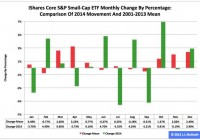Where Is The Market Going? Separating The Signal From The Noise
No one “knows” where the market will close tomorrow, let alone this year. That doesn’t stop gurus, seers, and writers from telling us which indicators will give us that inside edge. Read enough of them — or even two — and you realize you’re right back where you started. Instead, just concentrate on these important questions for your portfolio strategy. Journalists have to write x number of stories every week to fulfill their contracts. That doesn’t mean you have to read them and, if you still find amusement in so doing, it doesn’t mean you have to act on their advice. Thank heavens. Case in point. At 6:56 p.m. EST on January 6th, Mark Hulbert posted this piece on Marketwatch.com: “Opinion: A bear market in stocks just became more likely .” The gist of the article was summed up neatly in his first two sentences: “Bad news, investors: The Dow Industrials’ 300-plus-point drop Monday markedly increases the likelihood that the bull market has neared its end – if it hasn’t already. That’s because the stock market’s performance in the first two trading days of January has a surprisingly good record of forecasting the direction for the next 12 months.” Mr. Hulbert goes on to describe his pleasure at discovering this new tool, which is even better, he believes, than using the first five days of January as a tool to decide whether to consider investing for the year, and to note that the 1.8% decline in the first two trading days of 2015 were “even bigger than the 1.6% decline the Dow posted over the first two days of 2008, a fateful year that would later experience the worst bear market since the 1930s.” Give’s one pause, doesn’t it? Ah, but hot on the trail of this article comes one the very next day from Reuters titled, ” Here’s What Happened Those Other Times The S&P 500 Started the Year With 3 Down Days. ” The distinction is important, you see – this “indicator” uses the first three days of the new year, not merely the first two. Reuters’ Myles Udland reports on an e-mail sent by Jonathan Krinsky of MKM Partners that says, “During the eight years since 1928 that the S&P started with three-day losing streaks the index has returned 8.36% on average,” better than all years for the S&P since 1928. Well, there you have it. Since Mr. Hulbert’s data goes back to 1896 and Mr. Krinsky’s only until 1928, we are forced to draw one of two conclusions: There were a preponderance of less-than-pleasant market years prior to 1928 that began with 2 down days the first two trading days of the year, or It just doesn’t matter. I am firmly in the latter camp, call it the “Who Cares?” camp. What actionable offensive might an investor take armed with this information? I suppose if one were schizophrenic enough, they could have gone to cash after the second day and rushed back in the fourth day (after the “first 3 days” had passed.) But, really now, who makes their lifetime investing decisions like this? (I know, I know; more than I’d care to imagine.) Forget the First 2 Days / First 3 Days / First 5 Days Indicators and ask yourself this: Does the macro-economic and geopolitical environment favor the geographic and political regions in which you are investing? Are the sectors you favor undervalued or, if you anticipate superb results based on the first question, are they at least currently fairly valued? Do you currently have the appropriate mix of asset classes and individual funds, bonds and stocks to benefit from (or defend against) the market the first two questions lead you to invest in? Then, as the famous investment guru Aaron Rodgers recently said, “R-E-L-A-X.” Invest rationally. Read fewer articles written breathlessly about tea leaves, bones in a circle, or statistical correlation. There may be more kittens born in January than other months, too. Does that mean we should faithfully track the number of kittens born this month? Of course not; correlation does not mean causation. Sometimes it doesn’t mean anything at all… ________ As Registered Investment Advisors, we believe it is our responsibility to advise that we do not know your personal financial situation, so the information contained in this communiqué represents the opinions of the staff of Stanford Wealth Management, and should not be construed as personalized investment advice. Past performance is no guarantee of future results, rather an obvious statement but clearly too often unheeded judging by the number of investors who buy the current #1 mutual fund one year only to watch it plummet the following year. We encourage you to do your own due diligence on issues we discuss to see if they might be of value in your own investing. We take our responsibility to offer intelligent commentary seriously, but it should not be assumed that investing in any securities we are investing in will always be profitable. We do our best to get it right, and we “eat our own cooking,” but we could be wrong, hence our full disclosure as to whether we own or are buying the investments we write about.
